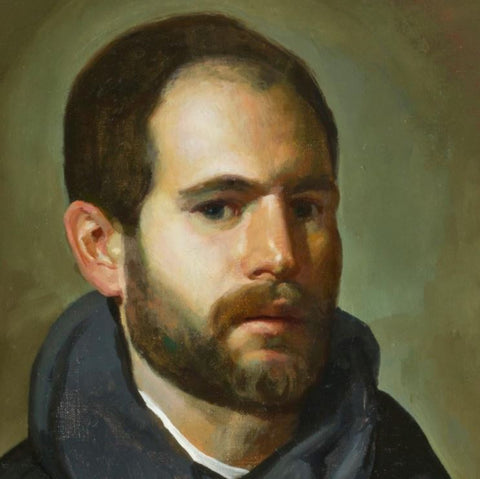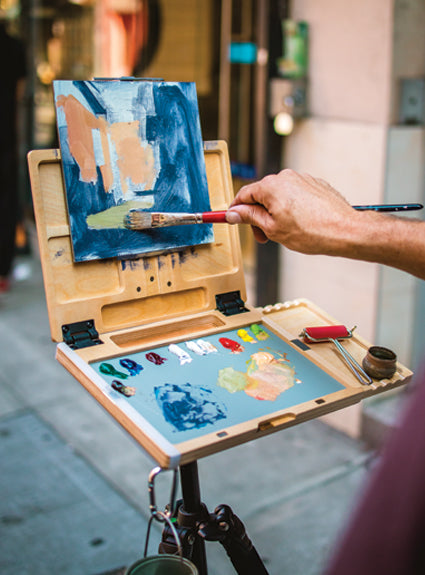INTERVIEW with NOAH BUCHANAN
LOCATION
Santa Cruz, CA
CAREER
Painter, Professor of Drawing & Painting
EDUCATION
Pennsylvania Academy of Fine Arts 1994 - 1996
University of California Santa Cruz, BA 2000
New York Academy of Art, MFA 2002

WHAT ARE SOME LITTLE KNOWN FACTS YOU WOULD LIKE TO SHARE ABOUT YOURSELF?
As a grad student, David Bowie once visited my studio and talked with others about my paintings... I was out having lunch :-)
My first drawings at age 4 and 5 were actually tracings of Spiderman, Batman, and Superman. I was always intrigued by how those illustrators depicted the “zipper-line” of, what I would one day come to know as, the serratus anterior and external oblique inter-digitation.
Startling Art Historical facts:
Michaelangelo’s father taught him that he should “rinse” himself, but never allow himself to be scrubbed. He followed his father’s advice throughout his life, by only rinsing himself occasionally.
We all know that Caravaggio killed a man in a duel over a tennis match. The reason his opponent died was that Caravaggio attempted to stab the man in the genitals, but missed and pierced the femoral artery. Classy!

THE PROCESS YOU IMPLEMENT IN YOUR OWN WORK, AND TEACH TO YOUR STUDENTS IS UNIQUE. CAN YOU PROVIDE SOME INFORMATION ABOUT ITS ORIGINS AND THE PROCESS ITSELF?
Most students I encounter seem to come to my courses with an interest in learning “Indirect Painting” techniques as per the 17th Century; for emulation of painters like Van Dyck, Rubens, Velazquez, Ribera, Rembrandt and even dipping back into the 16th century a bit for Caravaggio. The principal reason in practicing Indirect Painting is that it precipitates painting effects which are principally fleshy in nature, and of the flesh.
The stages of the Indirect Painting process involve:
1. A tonal ground of some type; often this is Red Iron Oxide with Lead White which is then augmented by a second layer of Lead White, Black of animal origin (Bone Black), and Iron Oxide with Manganese (Raw Umber). However, historic grounds have also been various earth pigments of differing color.
2. A washy, earthy preliminary underpainting layer: “Maniera Lavata” (washed manner) alternatively known as an “Imprimatura”, which mostly addresses shadows and darker values, while subtractively wiping away the lighter values. Contemporary painting students might know this as a “wipe out”, and it is simply a wash of earth pigments over the ground, which is then subtractively removed with rag and//or brush in order to achieve turning forms in the light mass. The shadows are augmented by further applications of the same earth pigments in order to bring about darker accents and more complex form.
3. A second layer of the underpainting focuses on building up the light mass exclusively, and is done so principally with Lead White (though often a tint of another color is added, such as Lead Tin Yellow, Iron Red Oxide, or Vermillion, as the artist prefers), applied to passages of light in a semi opaque/semi transparent manner. This is done with the addition of some medium into the paint, or onto the painting itself, and enables variation of the lead white paint through modes of opacity (at the brightest lights) and into transparency (at the darkest lights), allowing the viewer to see through this layer to the aforementioned Imprimatura layer. This entire stage is known as a Velatura. This can be made with Lead White only or it can also be done with a limited palette such as Lead White, Iron Oxide Red, and Bone Black. It is also very helpful, and historical, to include Calcite with the paint mixtures to achieve more transparency in the otherwise opaque paint.
4. Final layers, top layers of the painting, utilizing a full or limited palette, are painted over the underpainting with concerted efforts in maintaining an opaque Light Mass of thick bodied paint and a transparent Shadow Mass. This layer is full of color, detail, and formal information. Meanwhile, the shadow mass trends toward being transparent, earth tone, devoid of information (though this is not universally applied to every shadow throughout a painting; rather only where the transparent behavior functions with optimal effect). These final layers should show a proclivity for Velatura modes of layering in the light mass whenever/wherever possible.

TELL US ABOUT THE COLORS ON YOUR PALETTE AND ANYTHING NEW YOU HAVE BEEN EXPERIMENTING WITH?
For the past year or so I’ve been using a 17th century palette, which was inspired by the palette in Velazquez’s hand in Las Meninas. My own color palette is not quite as limited as the Las Meninas palette, but many of the following pigments were in use in Velazquez’s paintings at one point in his life or another. Here’s the palette (and I’ve noted the contemporary manufacturers that I use):
“Flemish White” (Utrecht). A Lead White paint made from “Stack Process” with long, ropy consistency.
Lead Tin Yellow (Michael Harding)
Yellow Ochre, Domestic (Williamsburg)
Mt Amiata Raw Sienna* (Kremer)
Stil De Grain* (Kremer)
Cyprus Raw Umber* (Kremer)
Bone Black (Rublev)
Azurite* (Rublev) or Cerulean Blue (Williamsburg or Michael Harding) as a stand-in for Azurite.
Smalt* (Rublev) Or Ultramarine Blue (Williamsburg) as a stand-in for Smalt.
Vermillion (Michael Harding)
Venetian Red (Rublev)
Red Madder Lake (Rublev).
*Some of these colors I hand grind myself
Further, I’ve been including Calcite (Calcite is Calcium Carbonate, or “Chalk”) in the paint for various effects. Reading the Brown/Garrido text on Velazquez led me to start incorporating chalk into the various paint layers for different effects.
Chalk is great for many purposes:
-As an extender (particularly for Grounds or large passages of a single color)
-Providing absorbency and leaner paint for earlier layers
-Lending thick body to paint for impasto effects
-Providing more transparency in the paint for indirect painting techniques such as Velatura.
The last is my principle interest in its use … I find that making a Velatura overpass on top of an underpainting (while mixing calcite into the paint) enables the painter to make a form pass over the lower layers of the painting in a mode which is neither fully opaque, nor fully transparent, thus allowing these layers to show through.
I often keep a gel on the side of the palette, which I mix from walnut oil and calcite; this makes the calcite more readily usable, integrative, with the paint.

WHAT ARE YOUR TOOLS OF CHOICE?
The paints I use are: Rublev (Natural Pigments), Kremer Pigments, Michael Harding, Williamsburg and Old Holland. I haven’t found a better lead white than Utrecht’s Flemish White.
The brushes are mostly sable rounds, or synthetic sable rounds, sizes 8 - 12 or thereabouts from Escoda, Performen and Trekell. But I love having a few rough Bristle brushes around of various sizes and shapes. And I’m surprised how much I turn to cheap hardware store 2” hogs hair bristle brushes.
Also, because I had studied for 2 years with Steven Assael in graduate school, I have developed an addiction for fan brushes mixed into the line up. As an innovation, I clip the sides of these off so that the fan brush is narrow like a “Flat”. These really create the equivalent of a sculptor’s “rake” for a painter, and help to pull paint “across the form”.
The medium I use is a very simple mixture of Walnut Oil from M.Graham mixed with Gamsol to various proportions in order to ensure Fat-on-Lean methodology. I’ve found over the years that I prefer Walnut Oil over Linseed Oil; when Linseed Oil dries, it passes through phases of wet, then sticky, then dry. That sticky phase attracts lots of dust. Meanwhile, when Walnut Oil dries, it passes through phases of wet, then wet, then wet, then dry. While it takes longer to dry, it doesn’t have sticky phase. I’ve found that my paintings have been cleaner and dust/debris free since I’ve adopted the practice of using Walnut Oil as a medium.
Most of my paintings are made on Lead Primed Linen from various manufacturers. Some I prime myself starting with Rabbit Skin Glue and then mixing up my own oil-based lead primer with lead white oil paint and calcite.

DO YOU HAVE ANY UPCOMING SHOWS OR WORKSHOPS?
BP Portrait Award Exhibition 2017. National Portrait Gallery, London. Opens on June 22nd, 2017. My painting will be in the BP Portrait Award 2017 Exhibition at The National Portrait Gallery in London. It was one of about 50 paintings chosen from over 2500 submissions for the show.
My work appears in the newly released "The Figurative Artists Handbook" by Robert Zeller, and it is a big, gorgeous book full of old masters and contemporary painters including a 2-page spread on my work as well.
BACAA 10-week courses in Figure/Portrait Painting and Drawing, ongoing in San Mateo, CA.
-Noah Buchanan
www.NoahBuchananArt.com









